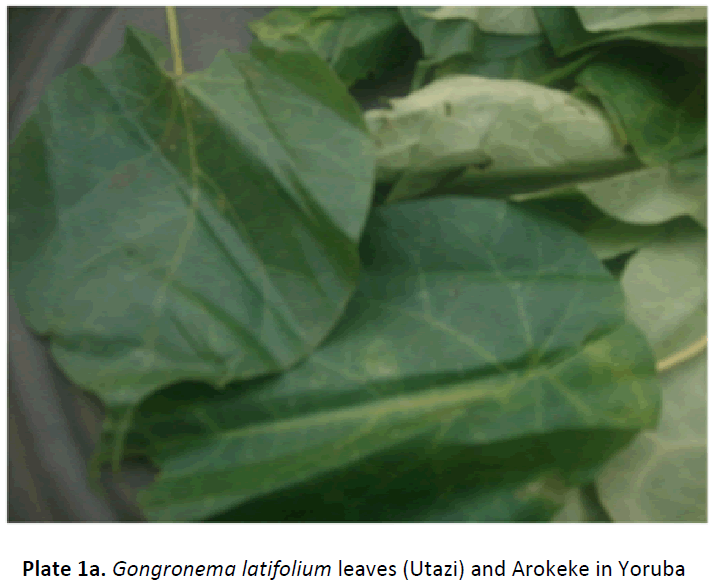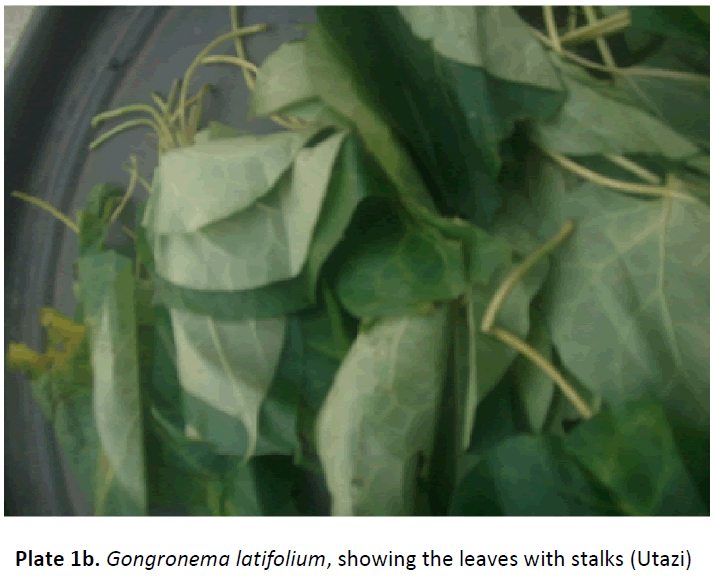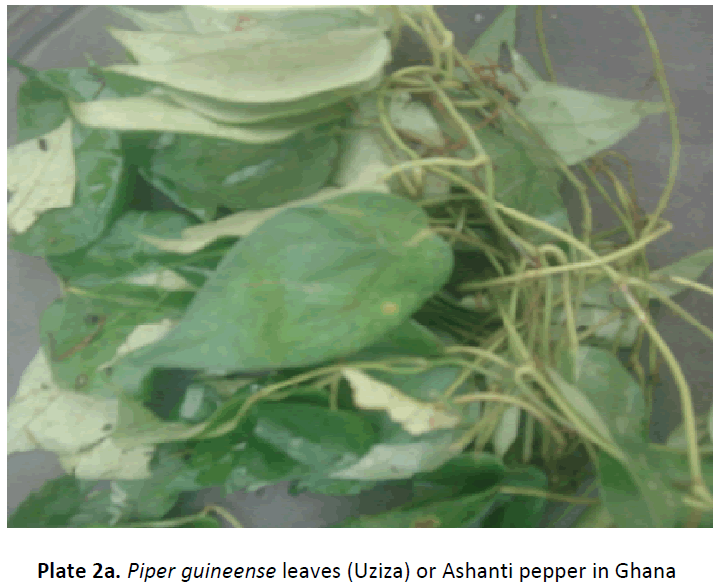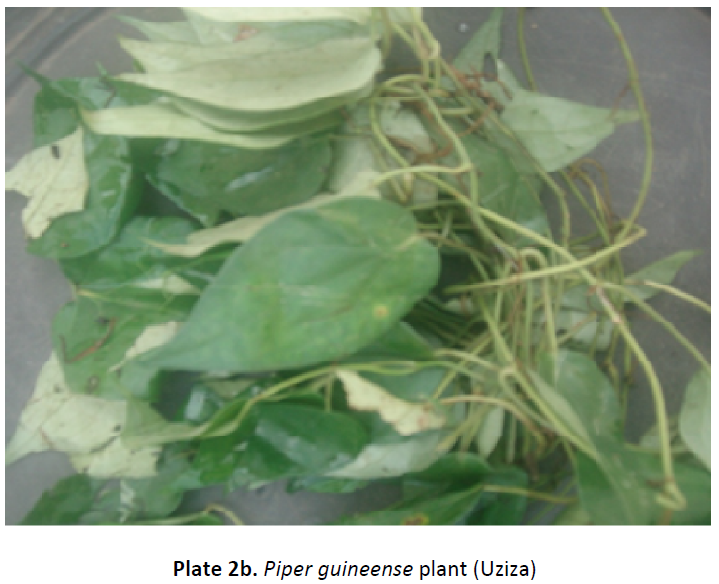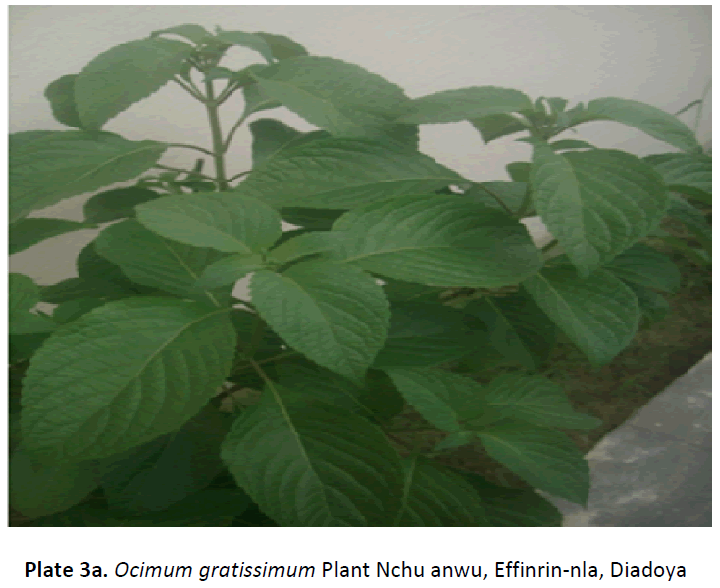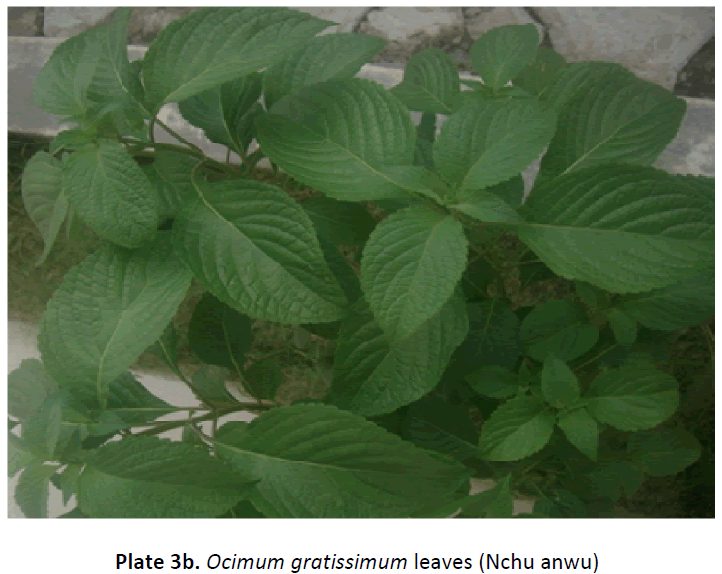ISSN : 2348-9502
American Journal of Ethnomedicine
Some Edible Spices of Southeastern Nigeria with Antiparasitic Properties: A Review
Department of Veterinary Parasitology and Entomology, Faculty of Veterinary Medicine, University of Abuja, Nigeria
- *Corresponding Author:
- Opara M.N
Department of Veterinary Parasitology and Entomology
Faculty of Veterinary Medicine
University of Abuja, Nigeria
Abstract
Records of information on the use of animal and plant parts to produce medicines are traceable to countries like China, India and Egypt. This indigenous knowledge was discovered through series of trials and then scientifically proved to be effective when compared to modern day medicines. Herbal remedies have thus become popular and therefore used in primary health acre deliveries of most countries. Fulani herdsmen of Nigeria and other peasant farmers also use herbs to treat their animals when they are sick and to prevent parasitic diseases. Variable successes have been reported on the use of orthodox medicaments for the treatment of internal and external parasites. However, their toxic effects on humans and livestock, the development of resistance to them by target parasites, as well as high cost of drugs, have led to the use of herbal remedies as reasonable alternatives. Herbal therapies are natural products, environmentally friendly and cheap. These short comings have thus, necessitated this study, which aims primarily to review the uses of Piper guineense, Ocimum gratissimum and Gongronema latifolium as alternatives to conventional antiparasitics.
Keywords
Piper guineense, Ocimum gratissimum, Gongronema latifolium, Environmentally friendly, Cheap.
INTRODUCTION
Piper guineense is a gnarled vine native to West Africa, which is used as a substitute for black pepper. Their leaves are heart – shaped, oval, petiolate, and alternate and 12 cm long. It is a perennial plant. The inflorescence is a pedicelled flower spike between 3cm and 6cm long. The peduncle and flowers are greenish yellow and arranged in spirally along the spine [1].
Ocimum gratissimum is a herbaceous plant which belongs to the Labitae family. The plant is indigenous to tropical areas especially India and also West Africa. In Nigeria, it is found in the Savannah and coarse areas. It is commonly grown in Ceylon, South Sea Islands, Nepal, Bengal, Chittagong and Decan [2]. It is known by various names in different parts of the world. In Nigeria for instance, the plant is called Effinrin-nla by the Yorubas, Ahuji or Nchuanwu by the Ibos and Diadoya in Hausa [3].
In other climes, this plant has extensively been employed in the traditional medicine. In some parts of Brazil, it is used both as medicine and for culinary purposes. The flowers and leaves of this plant are rich in essential oils, so it is used in preparation of teas and infusion [4].
In the southern parts of Nigeria, O. gratissimum is used in the treatment of epilepsy, febrile conditions and diarrhoea [3]. In the northern part of the country, decoctions of the leaves of O. gratissimum have been used to treat mental illness [5]. The Ibos of southeastern Nigeria use Ocimum gratissimum in sterilizing wound surfaces of their babies cord. It is also used in treatment of fungal infections, fever, cold and catarrhs6. The other minor tribes of Nigeria use the leaf extract for diarrheic cases and relief of stomach upset and hemorrhoids.
Gongronema latifolium (Asclepiadaceae) bush buck, an edible rainforest plant, native to South Eastern part of Nigeria, has been widely used in folk medicine as spices and as vegetable in making soup [7]. It is also used in maintaining blood glucose levels. Reports have revealed the antioxidant effect of extracts of Gongronema latifolium leaves [8]. It has equally been reported to enhance haemoglobin formation [9] and its blood pressure lowering properties [10] was attributed to the high magnesium content. The leaf extract also exhibits antibacterial activity [11], an anti-ulcer, and analgesic, with antipyretic properties [12]. The medicinal potentials of Ocimum gratissimum, Piper guineense and Gongronema latifolium, have been documented, thus, this work is an attempt to review these, including their anti-parasitic effects.
Origin and distribution of Ocimum gratissimum
Vegetables are good sources of carotenoids, vitamins, folate, phytochemical, dietary fibres and some minerals, but low in proteins, digestible carbohydrates and lipids [13]. They are very easy to cultivate and are used in combating vitamin and mineral deficiencies in low income countries. Ocimum gratissimum is cultivated and could also be found in the wild in the tropics and subtropics.
It is very viable in India and tropical Africa, from where it probably originated [14]. The leaves of the plant are used as both seasoning and vegetable. It has great medicinal values [15,16] but little is known about its nutritional and antimicrobial activities.
Botanical description of Ocimum gratissimum
Ocimum gratissimum is an aromatic, perennial herb, 1-3m tall; erect stem, round quadrangular, branched, glabrous or pubescent, woody at the base, often with epidermis in strips [17]. The leaves are situated opposite; petiole 2-4.5cm long, slender, pubescent, blade elliptical or ovate, 1.5- 16cm x 1-8.5cm, membranous, sometimes glandular, apex acute, puberulent or pubescent [17]. Fruit consisting of 4 dry, I seeded nutlets enclosed in the persistent carlyx (the flower lip closing the mouth of the fruiting carlyx); nutlet subglobose, 15mm long, rugose, brown, outer pericarp not becoming mucilaginous in water [17].
Functional uses of O. gratissimum
The plant is grown for its’ essential oil in the leaves and stems. The phytochemicals, Eugenol and thymol extracted are used in place of clove oil and thyme oil [18]. Both the plant and its’ essential oil have beneficial applications in herbal medicine, especially in Africa and India. Mixtures from the plant are used as stomachic, treatment of sunstroke, headache, convulsion and influenza [18].
The leaves are used as laxative and are prescribed against gonorrhea. It has also been proved to have antibiotic properties. The essential oil is also an important insect repellant. Tea is also made from the leaves, whole in Thailand; the leaves are applied as flavoring [18].
Medicinal values of O. gratissimum
The plant has an anti-convulsant quality which can be utilized for treating convulsive disorders. Traditionally, the herb is used to treat diarrhoea [19]. It has an antimalaria component that is used in treating diseases [20]. Concoctions are produced from this plant and used for treating skin infections, bronchitis and conjunctivitis [21]. It is also used in dressing wounds and as such acts as an antiseptic agent. The leaves are sometimes grinded and used as remedies for cough, while the roots act as sedatives for children [22].
Origin and distribution of Gongronema latifolium
Gongronema latifolium belongs to the family Asclepiadaceae. It is reported to have originated from Nigeria. G. latifolium is a rainforest plant, used locally in the South eastern part of the country for the management of ailments like diabetes, high blood pressure [12]. It is widely spread in tropical Africa and occurs from Senegal to Chad and to Democratic Republic of Congo [23].
Botanical description of Gongronema latifolium
Gongronema latifolium is a herbaceous, non-woody plant from the family of Asclepiadaceae. It produces milky or clear latex, widespread in the tropical and subtropical regions especially in Africa and America, with an average abundance in Northern and South eastern Asia [24].
Uses of Gongronema latifolium
G. latifolium is widely used in West Africa for ethno medicinal and nutritional purposes. An infusion of the upper parts can be used to treat cough, helminthiasis, dysentery, dyspepsia and malaria. It is also taken as a tonic to treat loss of appetite.
In Sierra Leone, the crushed stem, when mixed with lime juice is used to treat colic and stomach ache. In Senegal and Ghana, the leaves are rubbed on the joints of toddlers to help them walk, while the fruits are boiled in soup and taken as laxative.
In Nigeria, an infusion of the leafy stem is taken to treat diabetes and high blood pressure. It is called Utazi by the Ibo tribe of southeastern Nigeria, while the Yorubas call it Arokeke [24].
They taste sharp-bitter - sweet and widely used as vegetable for sauces, soups and salads [23].
Medicinal values of G. latifolium
Phytochemical analysis of the ethanolic extract of G. latifolium shows that the root contains polyphenols in abundance. Alkaloids, glycosides, flavonoids, terpenes, tannins, saponins and reducing sugars are also present in moderate amounts [11,25].
G. latifolium is also reported to have anti-oxidant [25] and anti-asthmatic potentials [26].
G. latifolium has anti-plasmodial activity, as demonstrated by the local use of the leaf extracts of the plant for the treatment of malaria [12]. The leaves, when evaluated were found to possess anti-ulcer, analgesic and antipyretic properties, as well as anti inflammation, antibacterial, antimalarial and antidiabetic [12].
The methanolic extracts of G latifolium show activities against Staphylococcus aureus, Listeria monocytogenes, Staphylococcus enteritidis, and Pseudomonas aeruginosa var typhimurium. The highest activity observed was against S. enteritidis, S. choleraesuis ser typhimurium and P. aeruginosa. But when water was used to extract the plant active components, the solution showed no activity against S. aureus [27].
Origin and distribution of piper guineense
P. guineense is commonly found in the tropical regions of Central and Western Africa. It is cultivated in countries such as Nigeria where the leaves, known as “Uziza” in Igbo language are used as flavorings for stew and local delicacies. Like other members of the pepper family, “Uziza” or “Ashanti pepper” contains 5-8% of the chemical in sufficient proportion (10%) of myristicin, etemicin, safrole and dillapoil28. In terms of flavor, this plant is very similar to cubeb pepper, but is much less bitter and has a fresher, more herbaceous flavour.
Botanical description of piper guineense
P. guineense is an African plant, of which two parts are used; the leaves and the berries. The leaves, which have peppery taste, are pale green in colour when fresh and darker green when frozen, dried or ground and dried. The leaves are used in soup making [29], either as whole or ground forms.
Economic values of piper guineense
It is very common, though little is known about its use in the treatment and prevention of sickness, allergy and running nose. The leaves have been reported to keep the body warm and prevent cold [28].
The different parts of this plant had been characterized and their chemical compositions determined. Some of these are not only used for food, but as therapeutic agents in minor ailments [28]. Constituents of Piper guineense (Uziza, Ashanti pepper or West African black pepper) is a herbaceous climber commonly found in the African tropical forest zones.
Some degree of nutritive value was early associated with the plant in Nigeria [26]. Phytochemical tests revealed the presence of alkaloids, tannins, Saponins, flavonoids, terpenoids and sugar in G. latifolium, P. guineense and O. gratissimum.
The ethanolic extract of the leaves of these plants have been reported to possess anthelmintic properties [30]. For instance, G. latifolium was observed to be more effective at 75% graded concentration in 1 hour, while P. guineense and O. gratissimum brought to death of helminth parasites at 3 hours.
CONCLUSION
The efficacies of conventional medicaments against internal and external parasites have been reported with variable success. Ethno medicines or plant extracts have become indispensable and are forming an integral part of the primary health care system of many nations, in treating man and his animals.
Thus, livestock production will be incomplete if cheap, less hazardous, environmental friendly, irresistible and effective anti parasitic agents are not considered or are neglected. Ocimum gratissimum, Gongronema latifolium and Piper guineense have great medicinal properties, in crude or processed forms. It is therefore recommended that drug manufacturers should harness the medicinal potentials in these plant spices and make their products available to livestock farmers. Meanwhile, farmers could take advantage of the beneficial properties of these plants in treating their animals, when they are sick.
Pictures of edible spices of southeastern Nigeria and their local names
REFERENCES
- Anonymous (2013):https://www.medterms. com/script/main/art.asp?.
- Nadkami, K.M. (1999): Indian materia medica, 3rd ed. Popular Prakashan Pvt. Ltd: Indian.
- Effraim, K.D, Jacks, T.W, Sodipo, O.A et al. (2003): Histopathological studies on the toxicity of Ocimum gratissimum leaf extract on some organs of rabbits. Afr. J.Biomed. Res., 6:21-5.
- Rabelo M., Souza, E.P., Soares, P.M.G. et al. (2003): Antinociceptive properties of the essential oil of Ocimum gratissimum L. (Labiatae) in mice. Braz. J. med. Res. 2003; 36:521-4.
- Akinmoladum, A.C, Ibukun, E.O, Emmanuel A, Obuotor, E.M et al (2007): Phytochemical constituent and anitioxidant activity of extract from the leaves of O. gratissimum. Sci. Res. Essay; 2:163-6.
- Ijieh I.I, Omodamiro, O.D, Nwanna, I.J (2005): Antimicrobial Effects of aqueous and ethanolic fractions of two species, Ocimum gratissimum and Xylopia aethiopica Afr. J. Biotech, 4:953-6.
- Morebise, O. M., J. M., Makinde et al. (2002): Anti inflammatory property of the leaves of Gongronema latifolium phytother. Res., 16:575-577.
- Ugochukwu, N.H., Babady, N.E., Cobourne M. and Gasset, S.R. (2003): The effect of Gongronema latifolium leaf extract on serum lipid profile and oxidative stress of hepatocytes to diabetic rats., J. Bio. Science, 28:1-5.
- Latunde-Dada, G.O. (1990): Effects of processing on iron levels and availability from Nigerian vegetables. J. Sci. Food Agric.; 355-361.
- Mensah, J.K, R.I. Okoli, J.O Ohaju-obodo and K. Eifediyi (2008): Phytochemical, nutritional and medicinal properties of some leafy vegetables consumed by Edo people of Nigeria. Afr. J. Biotechnology; 7:2304-2309.
- Nwinyi, O.C., Nwodo, S.C and Ajani, O.O. (2008): Evaluation of antibacterial activity of Psidum guajara and Gongronema latifolium. J. med. Plants Res., 2:189-192.
- Akudo, G.C, M.S. Idris-Usman, C.C. Mba, et al (2010): Studies on anti-ulcer, analgesic and antipyretic properties of the ethanolic leaf extract of Gongronema latifolium in rodents. African Journal of Biotechnology, 9:2316-2321.
- Wills, R., McGlasson, D., Graham, D. and Joyce, D. (1998): Post harvest, an introduction to the physiology and handling of fruit vegetables and ornamentals (4th edn.), CAB international, ISBN: 0851992641, Pp. 15-32.
- Wills, R., McGlasson, D., Graham, D. and Joyce, D. (1998): Post harvest, an introduction to the physiology and handling of fruit vegetables and ornamentals (4thedn.), CAB international, ISBN: 0851992641, Pp. 15-32.
- Gill, L.S (1992): Ethnomedical uses of plant in Nigeria, 1st ed. Uniben press, Benin City, ISBN: 978-2027-20-0 pp. 180-181.
- Simon, J.E, Quinn, J. and Murray, R.G. (1990): Brazil: A source of Essential oils. In: Advances in New crops, Janick, J and J. E simon (Eds). Timber press, Portland Pp. 484-489.
- Orwa, C., Mutua, A., Kindt, R., et al (2009): Agro forestree Database: a tree reference and selection guide version 4.0 (https:// www.worldagroforestry.org/af/treedb/).
- Sulistiarini, D., (1999): Ocimum gratissimum L. In Oyen, L.P.A and Nguyen Xuan Dury (Eds): plant Resources of South- East Asia. No. 19: Essential-oil plants. Prosea Foundation, Bogor Indonesia. Pp.140-142.
- Iwu, M.M., (1993): Handbook of African medical plants. Florida: CRC press Inc. Boca Raton, USA.
- Dalziel, J.M. (1956): Useful plants of West Tropical Africa: London: Crown Agents for overseas Govts.
- Oliver, E (1960): Medicinal plants in Nigeria. Ibadan, Nigeria: Nigeria college of Arts, Science and Technology.
- Distazi, L.C., Oliveiva, G.P Carval haes, M.A., Queiros, M., et al. (2002): Medicinal plants popularly used in the Brazilian Tropical Atlantic Forest. Fitoterapia. 2002; 73:69-91 (Pubmed).
- PROTA: (2013):www.prota4u.org/protav8. asp?h=m4&+=Gongronema latifolium and P=Gongronema + Latifolium.
- Agbo, C.U, Baiyeri, K.P and Obi, I.U (2005): “Indigenous Knowledge and utilization of G. latifolium Benth: a case study of women in University of Nigeria, Nsukka Bio-Research Journal, vol. 3, no. 2, pp. 66-69.
- Atlas, C. and Lindel G. (1996): Food Biochemistry, Aspen publishers Inc., Gaithersburg, Maryland, USA.
- Sofowora, A. (1993): Medicinal plants and Traditional medicine in Africa. Pub. John Wiley and Sons Limited.
- Eliyinmi, A.F., (2007): Chemical composition and antibacterial activity of G. latifolium. Journal of Zhejiang University sci. B, 8:352-358.
- Martins (2013): https://www.martinslibrary. com.
- Cooks info (2012): https://www.cooksinfo. Com.
- Ibiam, U. K. (2013): In vitro study of the anthelmintic effects of ethanolic extract of Gongronema latifolium, Piper guineense and Ocimum gratissimum on helminths of cattle. Project for the award of B. Agric. Tech., Federal University of Technology, Owerri, Nigeria.
Open Access Journals
- Aquaculture & Veterinary Science
- Chemistry & Chemical Sciences
- Clinical Sciences
- Engineering
- General Science
- Genetics & Molecular Biology
- Health Care & Nursing
- Immunology & Microbiology
- Materials Science
- Mathematics & Physics
- Medical Sciences
- Neurology & Psychiatry
- Oncology & Cancer Science
- Pharmaceutical Sciences
